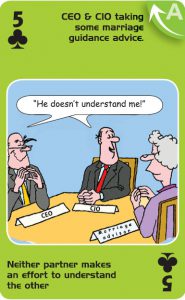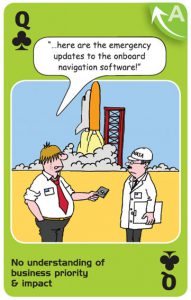Behave Yourself…Or Else!
When I contributed to GamingWorks’ book ‘ABC of ICT’ in 2007, little did I imagine that, ten years later, I’d be writing about the series of business-IT behaviour workshops that I have conducted across more than ten countries, and how my participants’ opinions relate to the top ten issues according to the thousands of people who have played the ABC for ICT card game. There’s a great deal of correlation between both sources, and I believe that together, they pinpoint some key areas that need to be addressed.
Table of Contents
ToggleDesired business-IT behaviour
I’ve conducted my business-IT behaviour exercise in the UK, Ireland, Finland, Norway, Slovakia, Belgium, Poland, Australia, Japan, The Netherlands, and Austria. This has been done in various formats, most recently with Simone Jo Moore in our Behave Yourself workshop, that explores the iceberg with visible behaviour above the waterline, and the underlying emotions, thoughts, beliefs and values that actually drive behaviour. In this exercise, the participants are split into two ‘factions’, business and IT. In practical terms, business discussion tables and IT discussion tables are formed, each with about 5 people per table. The business groups are asked what kind of behaviour they would like to see from their IT colleagues, and vice versa for the IT groups. After about 15 minutes’ discussion, each discussion table reports back to the plenary group and the findings are captured. After each workshop, I review my top six desired business behaviours and top six desired IT behaviours, and decide whether this compilation needs updating. The current top desired behaviours are as follows:
Business people should:
- Ask for outcomes, not solutions
- Articulate strategy and needs clearly
- Accept risks, set priorities, take decisions
- Understand IT’s limitations
- Own organizational change
- Give feedback about use
IT people should:
- Be accessible, quick, empathetic, communicative and flexible
- Understand the business and IT’s impact
- Talk benefits, costs and risks
- Discuss consequences
- Suggest innovations
- Say “Yes, if”, not “No”
In addition to these behaviours, there are often comments about the desired culture in the organisation. This is currently “business and IT share a joint vision, have an ongoing dialogue, have mature conversations, strike balances, and enjoy working together”.
World-wide worst practices
Since time immemorial, GamingWorks has focused on identifying – and addressing – issues with attitude, behaviour and culture. Their founders Paul Wilkinson and Jan Schilt have developed various instruments to support their mission to help organisations get more value out of their investments in training. One of their most accessible ‘tools’ is the ABC for ICT card deck, comprising 54 card with ‘worst practices’ and a humourous cartoon to make the point. For example the Queen of Spades, that both business people and IT people have chosen as their top (or bottom) worst practice.

In a similar fashion to my approach with the behaviour workshop findings, GamingWorks has compiled a top ten of word-wide worst practices, listed below.
- IT has too little understanding of business impact and priority
- Business says that everything has the highest priority
- Neither party makes enough effort to understand each other
- IT is too internally focussed
- Too little business involvement in requirements specification and testing
- IT does not measure their value contribution to strategy
- IT is not seen as added value partner to the business
- IT thinks it does not need to understand the business in order to make a business case
- Business demands are short-sighted and IT blindly follows orders
- Mutual lack of trust and credibility – a broken business-IT relationship
Worst practice and desired behaviour
In order to give to suggestions as to how these worst practices can be addressed, here is a mapping of each worst practice and the appropriate desired behaviour, followed by some comments.
- IT has too little understanding of business impact and priority
- Understand the business and IT’s impact
This is one of the first findings to emerge in most of the workshops. It illustrates the divide between business and IT. This is often a physical divide, with IT people working on separate flours, buildings, and even countries, but it is often also lack of ‘mental co-location’.
- Business says that everything has the highest priority
- Accept risks, set priorities, take decisions
This desired behaviour emerges in various forms, but ‘business ownership’ is the common denominator. The key question is why business people are happy to leave things to IT and blame them afterwards. Maybe they just have better things to do.
- Neither party makes enough effort to understand each other
- Understand IT’s limitations
- Understand the business and IT’s impact
A ‘marriage counsellor’ is often needed to get two parties onto speaking terms. The role of Business Relationship Manager is a suitable candidate to take the initiative.
- IT is too internally focussed
- Understand the business and IT’s impact
- Talk benefits, costs and risks
- Discuss consequences
- Suggest innovations
The remedy here starts with understanding of the business, but needs to be supported by communication skills and a change in mindset that IT is not a subservient order-taker but is also responsible for getting value out investments in IT.
- Too little business involvement in requirements specification and testing
- Own organizational change
- Give feedback about use
This is a case of priorities and skills in the business. It is strongly related to ‘business ownership’ as mentioned in #2.
- IT does not measure their value contribution to strategy
- Articulate strategy and needs clearly
This is the first worst practice that has no match to a desired IT behaviour but a frequently made comment is that the business should be clearer in telling IT where it’s going and what it needs.
- IT is not seen as added value partner to the business
- Understand the business and IT’s impact
- Talk benefits, costs and risks
- Discuss consequences
- Suggest innovations
Various items can remedy this issue. They are related to knowledge, communication skills, and a proactive mindset.
- IT thinks it does not need to understand the business in order to make a business case
- Understand the business and IT’s impact
A ‘meta-understanding’ issue: lack of understanding by IT that IT needs understanding of the business!
- Business demands are short-sighted and IT blindly follows orders
- Ask for outcomes, not solutions
- Understand IT’s limitations
- Talk benefits, costs and risks
- Discuss consequences
- Say “Yes, if”, not “No”
It takes two to tango and both business and IT need to act here. The business need to ask the right questions and be prepared to accept the answer. IT has to have the ability to talk about IT without mentioning IT – what are the consequences of what the business asks for in terms of benefits, costs and risks? This is also related to the final issue.
- Mutual lack of trust and credibility – a broken business-IT relationship
- Fosters a culture in which business and IT share a joint vision, have an ongoing dialogue, have mature conversations, strike balances, and enjoy working together
Strong relationship with #3: neither party makes enough effort to understand each other. This is an opportunity for the Business Relationship Manager to contribute.
Change the setting, change behaviour
So, ten years later, what’s the bottom line? I’d draw the conclusion that although business people and IT people need to improve some ‘technical’ skills, the main problem is not only the mutual lack of understanding but also the lack of motivation to actually do anything about the situation. Paul and I have been around long enough to have noticed that this aspect never seems to change. Let’s have a think about change. Results are achieved by behaviour, and behaviour is driven by emotions, thoughts, beliefs and values. These behaviour drivers can be changed in various ways but in this case, I’m drawn to a change in the organisational setting, putting people in the same (small) boat where they can’t hide. So decentralise IT to the various lines of business and create multidisciplinary teams (small enough to be effective work units) with a common business goal and enough autonomy to motivate them, and have them report to the same (business) management. It’s worth a try because in the traditional segregated business-IT setting, each party seems happier to keep its distance and derive satisfaction from pointing to each other when things go wrong. You could say that I’m cynical, and you might be right. Frustratingly, I simply can’t arrive at any other conclusion. Let’s see what Paul has to say:
Having also spent more than 10 years banging my head against a brick wall I agree with Mark. Particularly this statement: “It takes two to tango”. This cartoon was the number 3 card mentioned above.

Business and IT are like an old married couple. As Mark said, what they need is a marriage guidance counsellor. The difference between a real marriage and the business-IT marriage is that in the business-IT marriage only one party can outsource the other! IT can no longer afford to play the victim. IT must step up to the plate. Who can play the role of the marriage guidance counsellor? Enter the BRM (Business Relationship Manager), both as a role and a capability, a fast-growing area of practice. My recommendation is for IT organizations to develop this as a core capability.
One concrete step to start with? Send everybody in IT into the business for a day to see how IT is used and how it contributes to business value creation or causes value leakage.
Mark mentioned the lack of understanding and motivation. It is also an inability to communicate. Both business and IT need to improve the way in which they communicate. This article on CIO.com from 2015 explains the seriousness of the issue ‘Communication between IT and non-IT workers in a state of crisis’.
In this age of digital transformation and the growing importance of and dependency upon IT, the consequence of not changing behaviour is failure, which is not an option.




